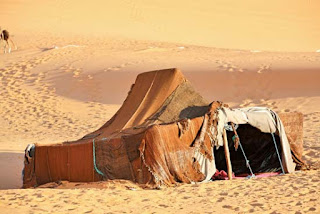BERBER TRIBES of North Africa
Berbers or Amazighs are an ethnic group indigenous to North Africa, primarily inhabiting the Maghreb. They are distributed in an area stretching from the Atlantic Ocean to the Siwa Oasis in Egypt, and from the Mediterranean Sea to the Niger River in West Africa. Historically, they spoke Berber languages, which together form the Berber branch of the Afroasiatic family. Foreign languages, mainly French and to some degree Spanish, inherited from former European colonial powers, are used by most educated Berbers in Algeria and Morocco in some formal contexts, such as higher education or business.
The economy was largely subsistence agriculture and pastoralism practiced by farmers, transhumants, and nomads, coupled with weaving, pottery, metalwork, and leatherwork, and local and some long-distance trade. Dwellings varied from caves to pitched-roof houses to flat-roofed “castles” to tents. Whatever the dwelling, its construction was designed to create an interior ruled by the women of the family. Outside the home, women would gather at the fountain or well and at the tomb of the local saint, whereas men would meet at the mosque or in the street and square. In the case of the nomadic and matrilineal Tuareg of the central Sahara, the camp was largely controlled by the women, who chose their husbands and, with their songs, were central to social gatherings.
The Berbers live in scattered communities across Morocco, Algeria, Tunisia, Libya, Egypt, Mali, Niger, and Mauretania. At the turn of the 21st century, there were perhaps 14 million in Morocco, 9 million in Algeria, and much smaller numbers in Tunisia, Libya, Egypt, and Mauretania; in the Sahara of southern Algeria and of Libya, Mali and Niger, the Berber Tuareg number about 1 million.
Prehistory
The presence of proto-Berber peoples from prehistory is evident in Saharan caves, where rock paintings depicting diverse megafaunal life point to evidence that before the desertification of the Sahara, northern Africa was a lush and resource-rich region populated by hunter-gatherer societies. The basal two deities of Berber cosmology - a solar figure and a lunar one - are loosely analogous to those of the Egyptians, suggesting a common cultural origin. According to Herodotus, who in his Histories wrote of the Berbers in 430 BCE,
In common with pre-Abrahamic Middle Eastern peoples, the importance of rocks was a major theme in Berber tradition. Some stone-cut mausoleums, such as the Roman-era Royal Mausoleum of Mauritania, built by Berber kings in traditional style, remain intact today. The Berber veneration of stone structures, which included the burial of the dead under outcroppings or erected monuments, was akin to such practices as the Nabatean pilgrimage to the Black Stone at Mecca’s Kaaba and the Arabian Hutaymi people's worship of the great boulder Al-Weli abu Ruzuma. Similarities in tradition and language point to an ancient proto-Afroasiatic cultural center from which these groups dispersed.
Modern History
From about 2000 BCE, Berber (Amazigh) languages spread westward from the Nile valley across the northern Sahara into the Maghrib. By the 1st millennium BCE, their speakers were the native inhabitants of the vast region encountered by the Greeks, Carthaginians, and Romans. A series of Berber peoples—Mauri, Masaesyli, Massyli, Musulami, Gaetuli, Garamantes—then gave rise to Berber kingdoms under Carthaginian and Roman influence. Of those kingdoms, Numidia and Mauretaniawere formally incorporated into the Roman Empire in the late 2nd century BCE, but others appeared in late antiquity following the Vandal invasion in 429 CE and the Byzantine reconquest (533 CE) only to be suppressed by the Arab conquests of the 7th and 8th centuries CE.
It was the Arabs, who had enlisted Berber warriors for the conquest of Spain, who nevertheless gave those peoples a single name, turning barbarian (speakers of a language other than Greek and Latin) into Barbar, the name of a race descended from Noah. While unifying the indigenous groups under one rubric, the Arabs began their Islamization. From the very beginning, Islam provided the ideological stimulus for the rise of fresh Berber dynasties. Between the 11th and 13th centuries, the greatest of those—the Almoravids and the Almohads, nomads of the Sahara and villagers of the High Atlas, respectively—conquered Muslim Spain and North Africa as far east as Tripoli (now in Libya). Their Berber successors—the Marinids at Fès (now in Morocco), the Ziyanids at Tlemcen (now in Algeria), and the Ḥafṣids at Tunis (now in Tunisia) and Bijaya (now Bejaïa, Algeria)—continued to rule until the 16th century.
Meanwhile, Berber merchants and nomads of the Sahara had initiated a trans-Saharan trade in gold and slaves that incorporated the lands of the Sudan into the Islamic world. Those achievements of the Barbar were celebrated in a massive history of North Africa (Kitāb al-ʿIbār) by the 14th-century Arab historian Ibn Khaldūn. By then, however, the Berbers were in retreat, subjected to Arabization of two very different kinds. The predominance of written Arabic had ended the writing of Amazigh (Berber) languages in both the old Libyan and the new Arabic script, reducing its languages to folk languages. At the same time, an influx from the east of warrior Arab nomads from the 11th century onward was driving the Berbers off the plains and into the mountains and overrunning the desert. Together those factors were turning the population from Berber speakers into Arabic speakers, with a consequent loss of original identities. From the 16th century onward the process continued in the absence of Berber dynasties, which were replaced in Morocco by Arabs claiming descent from the Prophet and elsewhere by Turks at Algiers, Tunis, and Tripoli
When the French conquered Algeria in the 19th century and Morocco in the 20th, they seized on the distinction between the Arab majority and the Berbers of the mountains. On the strength of Ibn Khaldūn’s history, the latter were once again classified as a people under their modern name of Berbers. The identification and description of their language, the anthropological study of their society, and their geographical isolation all gave grounds for their separate administration as a people going back before the time of Islam to a pagan and Christian past. Those colonial studies and policies have determined much of the history of the Berbers down to the present but meanwhile have left a record of their manners and customs before the advent of modernity.
https://www.britannica.com ~ https://en.wikipedia.org ~ https://www.ancient.eu/Berbers/


Comments
Post a Comment